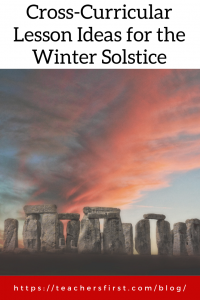The Winter Solstice is the time of ending and beginning, a powerful time — a time to contemplate your immortality. A time to forgive, to be forgiven, and to make a fresh start. A time to awaken.
Frederick Lenz
It isn’t always possible to create well-developed cross-curricular lessons based upon a single theme. Still, many themes adapt perfectly to building exciting lessons that span the curriculum. The winter solstice comes at a perfect time for creating tasks that include strong academic content while still encouraging student interest and excitement in learning activities.
This year the winter solstice takes place in the northern hemisphere on December 21 at 10:59 EST. On this day, residents of the northern hemisphere experience the shortest number of daylight hours in the year. For example, in Fairbanks, Alaska, daylight is only 3 hours and 54 minutes long, while Bogota, Columbia, is lucky to enjoy over 12 hours of sunlight.
The solstice is much more than an annual occurrence. It is the astronomical first day of winter and signals the changing of seasons. Many cultures celebrate the change of seasons in different ways. Due to the cultural significance of the winter solstice, it becomes an excellent topic to incorporate into other areas of the curriculum.
Let’s take a look at some ideas on how to integrate the winter solstice in a variety of content areas:
Science:
- The solstice occurs due to the tilt of the earth away from the sun. On December 21, the northern hemisphere is tilted as far away from the sun as possible. Have students stand outside at noon and measure the length of their shadow. Do the same each month to observe the differences in shadow length throughout the year. Why is it different?
- Share this excellent interactive from PBS with students to visualize how the earth’s orbit around the sun and tilt causes seasons.
Math:
- Use the amount of daylight to reinforce the concept of more than and less than to younger students. For example, create a flashcard game with varying amounts of suns for two players to play. After each player pulls a card from the face-down deck, the player with the few cards keeps both. The game goes on until one player has all of the cards.
- For older students, calculate the sun’s angle based upon your geographic location. Find the angle in other northern hemisphere sites to understand why different areas received different amounts of sunlight on the same day.
Language Arts:
- Stock your classroom library with books about the winter solstice. This list provides some ideas to get started.
- Write winter poems and haikus or short stories about the shortest day of the year.
- Write fiction stories about what happened one day when the sun’s tilt got accidentally changed.
Social Studies:
- Many cultures around the world celebrate the winter solstice in different ways. Learn about the variety of celebrations as a starting point for learning about countries and cultures worldwide.
- Use Genially (reviewed here) to create an interactive map that includes links to countries worldwide. When adding links include videos, music, websites, and student-created text to share information on solstice celebrations across the globe.
One resource for organizing resources is Wakelet (reviewed here). Wakelet’s column feature makes it easy to collect information by content area. This example contains many resources to use as a starting point for a winter solstice cross-curricular unit. Use the link to duplicate this collection and edit it to fit your needs.
Wakelet is also a fantastic tool for students to share their learning. For example, this template presents a guideline for students to research a famous person. Duplicate the template, then edit to change it a research project based upon students’ understanding of seasonal changes, cultural celebrations of the winter solstice, or a comparison of seasonal changes around the globe. Another easily adaptable example is this collection that shares students’ recordings and reports about young people making a difference in the world.
Learn more about the many uses for Wakelet by watching the on-demand recording of our OK2Ask workshop, Tech Integration Made Easy with Wakelet. Wakelet makes it easy to curate, collaborate, and create content in all subjects and grades!
Although the winter solstice is the shortest day of the year, it also signals the beginning of the sun’s return. Using a cross-curricular approach to teaching about this annual event provides students a deeper insight into the impact of the sun on the earth in many ways, both scientifically and culturally.
What suggestions do you have for teaching about the winter solstice? Do you have cross-curricular ideas to share? We always enjoy learning together with our readers. We’d love to hear your strategies in the comments below!


